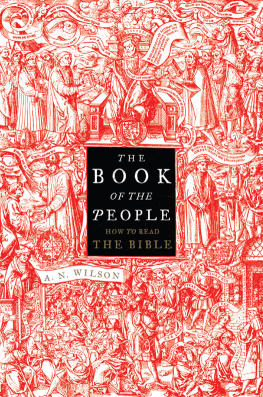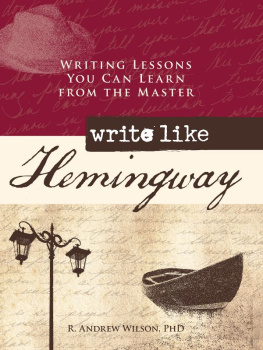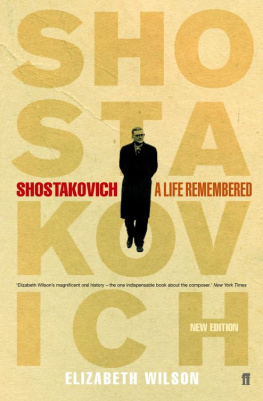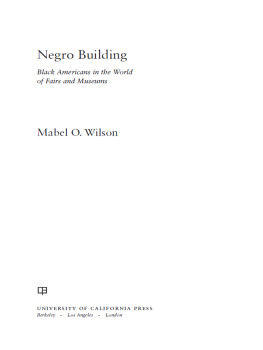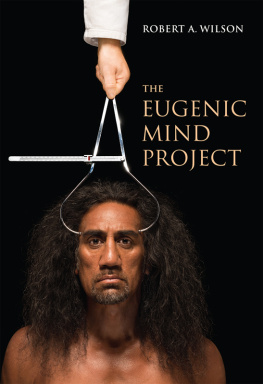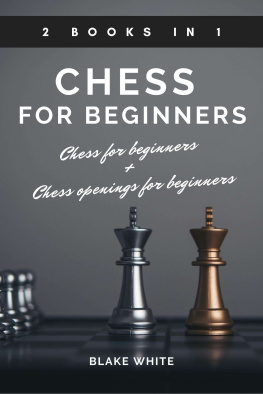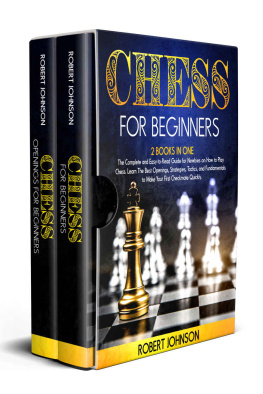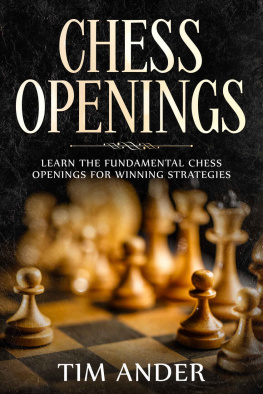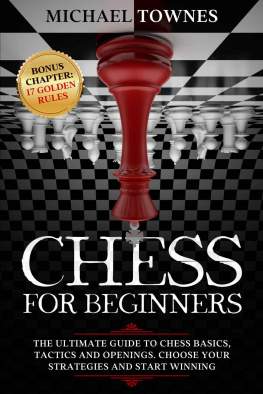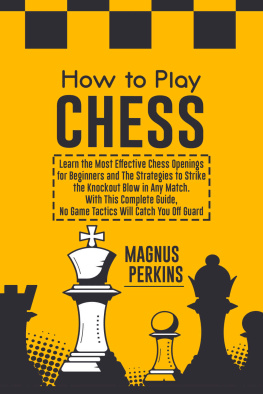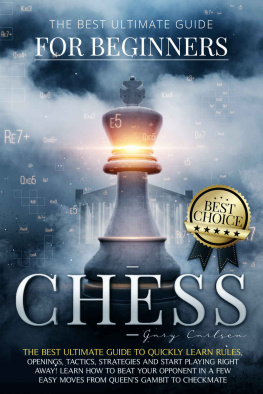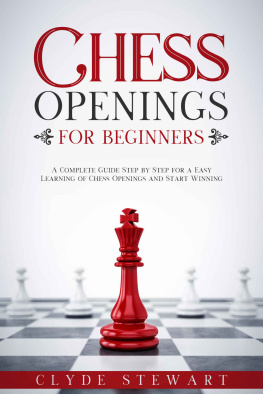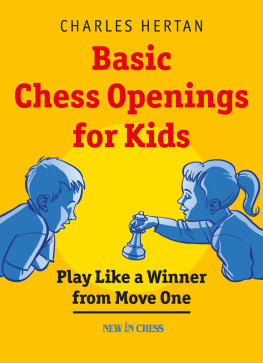Chess for Beginners
Copyright Garry Wilson 2020
Copyright Garry Wilson 2020.
All rights reserved.
First Printing Edition, 2020
BOOK INTRODUCTION
This Book is specially designed for those who want to learn how to play chess. There is a simple and progressive explanation of all the rules you need to know to play a game of chess.
The important thing to progress in chess is not to retain a bunch of variations and openings, but to seek to better understand the stakes of a game.
It will not be a question here of learning to calculate all the possible combinations several moves in advance, but of mentally visualizing the future of a game 10 or 20 moves later, almost without calculation.
Impossible? Not really. This is achieved by studying the structure of the game and imagining how the game will evolve, and then change its course in the long term.
No need to waste your time learning things by rote or to waste your eyes on complicated chess books. Read the few simple tips that follow and play. You will see, the rest will come by itself.
BOOK CONTENTS
BOOK INTRODUCTION
CHAPTER ONE; INTRODUCTION TO THE GAME OF CHESS
CHAPTER TWO; UNDERSTANDING THE RULES OF CHESS
CHAPTER THREE; SMALL MANUAL OF CHESS STRATEGY.
CHAPTER ONE
INTRODUCTION TO THE GAME OF CHESS
Archaeologists have more than once discovered objects that could have been chess pieces. These objects date back thousands of years. Could it be possible that Roman senators, Greek philosophers, or even Egyptian pharaohs played this early game of chess? Was chess played around the Hanging Gardens of Babylon and in the courtyards of the palaces of Ur? It seems doubtful, obviously.
Nathan Divinsky, in his admirable encyclopedia The Batsford Chess Encyclopedia, sums up the generally accepted opinion: "It is improbable that the game of chess existed long before the year 600, given the absence of references in the history of intellectual Greece or that of Imperial Rome. "
Most historians now agree that the oldest pieces date from around AD 600. This is also the approximate date of the earliest references to chess in literature. The author is a Persian who reports a game similar to ours called chaturanga and came from India by the main trade routes. If we add a few decades so that the game becomes commonplace and that we begin to talk about it, then that it makes its way to Persia, we can assume that the game of chess was invented in India during the 6th century AD.
Where Did The Idea For The Game Of Chess Come From ?
Chaturanga, from Sanskrit texts, means "quadripartite", that is to say divided into four parts. The Indian army of the time was also called Chaturanga and consisted of four corps: elephants, horsemen, tanks and infantry. Thus, two possible explanations for the genesis of failures arise:
The game of chess was a representation of war or a bloodless training ground for war.
The game of chess was a way of recreating reality in miniature, just like in today's games where we can buy and sell land and hotels with fancy banknotes.
In chaturanga, the moves were decided by the throwing of the dice. This offers another theory on the creation of the game: This ancient form of the game of chess was a way of predicting the future or receiving messages from the gods. David Hooper and Kenneth Whyld, in their Oxford Companion to Chess, propose this scenario:
By directing falling objects on a divination plane, the gods could communicate with mortals. Later, the dice were added to imperatively designate the pieces to be moved and thus reveal more of the divine intentions. Then a sacrilege had the audacity to convert the process into a game, perhaps eliminating the dice at that point. It is undoubtedly this person who, having secularized the religious rite, has the most right to the title of "inventor" of the game of chess. "
How Was Chess Played In The Old Days ?
Compared to the pace nowadays, the game was slow! The chaturanga played four partners. Each player had eight pieces: four pawns, a boat or chariot (our tower), a horse (our rider), an elephant (our bishop) and a king.
The moves were designated by the throwing of red, green, yellow and black dice. (Unfortunately, we don't know exactly what dice referred to moves on the chessboard, as there is no guide left from this time.)
The elephant could only move two squares diagonally, while still being able to jump over any room in its path. The pawn could not move two squares on its first move and, once it reached the eighth row, could not be promoted to any rank. Castling did not exist. There was also no Queen, whose power nowadays allows you to change the course of a game in one fell swoop. The tower, the rider and the king moved as they do today.
You could play two against two or each for yourself. So try to play by these rules, but make sure you have time in front of you!
You will also be required to make your own chessboard. Our ancestors already played on a chessboard of 64 squares, but without color (it was a European invention).
First of all, the four-way game is gone. The Persians only played two. Each player now has an army of 16 men, like us today, but the movement of the pieces was as restricted as we saw above, even in the case of the new adviser placed alongside the king. (Perhaps it was the suppressed kings of the Indian game that became the advisers of the Persian game.) The advisor could only move one square diagonally, which made him barely more powerful than a pawn. The two-man game was just as slow as the four-man game.
The Persian game could be played with or without dice. It was only after a few centuries that the dice disappeared completely. The last mention of the dice appears in the thirteenth-century European literary work in which a gentleman asks the object of his love: "Madame, how do you want to play, with or without the dice?" "
The spread of chess to the west accelerated in the 7th century as the expanding Arab Empire conquered Persia. Over the next four centuries, Arabs became the best players in the world. We still know the names of these champions today, as well as a lot of their writings and endgame issues they imagined.
The game of chess has also ventured east. Across Asia, it has taken on very different forms from what Westerners practice. In Chinese chess, xian qi, for example, the pieces are not placed on the squares, but on the intersections of the lines of the grid. A river passes through the middle of the chessboard which is made up of 9 out of 10 squares; each player has a redoubt where he can take refuge; some pieces cannot leave the redoubt; others cannot cross the river, still others look like ours, but there is no Queen. The object of the game is always to checkmate.
Japanese chess, the shogi, entered Japan from China through Korea. Shogi is played on a 9 x 9 square chessboard. The pieces are arranged in three rows instead of the two in our game. As in Chinese chess, there is no queen. The easiest pieces to identify (by our standards) are Kings - but each player has three. Despite these three kings, the goal of the game is also to checkmate. The biggest difference with our western game is that the captured pieces change sides!
How Did The Game Of Chess Come To Europe ?
The game of chess came to Europe by several routes. The Arabs invaded the Iberian Peninsula, which would one day become the kingdoms of Spain and Portugal, as well as Sicily in the 8th century, and naturally they brought the game of chess with them. The nascent Italian cities, the nucleus of what would one day become Italy, were carving out empires around the Mediterranean and the merchants of Venice and Genoa soon discovered the failures.


